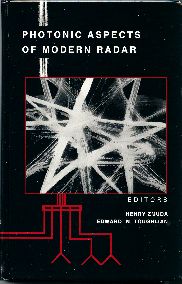
Photonic Aspects of Modern Radar
H. Zmuda and E. N. Toughlian, eds.
Artech House, 1994, 550 pages

|
 he title of this book is somewhat misleading.
The book does not discuss radar signals as photons as the title suggests,
and there is no discussion of lidar or even millimeter-wave radar.
Instead, the book is directed at radar engineers interested in incorporating
conventional optical and electro-optical components into their systems.
he title of this book is somewhat misleading.
The book does not discuss radar signals as photons as the title suggests,
and there is no discussion of lidar or even millimeter-wave radar.
Instead, the book is directed at radar engineers interested in incorporating
conventional optical and electro-optical components into their systems.
Each chapter is written by an author specializing in a different area. The book starts out with a review of basic radar theory, which will undoubtedly be skipped by most readers. It then proceeds on a grand tour of various aspects of optical signal processing technologies that have potential use in radar and microwave signal transmission systems, including fiber optics, spatial light modulators, acousto-optical Bragg cells, fiber optic delay lines, and optoelectronics.
In a few of the chapters, the connection with radar is somewhat tenuous. This was particularly true for the chapter on Bragg cells. The acousto-optical Bragg cell has to rank as one of the cleverest inventions of all time. In a Bragg cell, a sound wave is transmitted into a solid medium to create a standing wave. A laser beam passing through the crystal is then able to convert the device into a broadband RF spectrometer that obtains real-time power spectra of radio waves between 30 MHz and 6 GHz. This application is not mentioned, however, until chapter 16.
Although some chapters contain awkward technical slang like "-3dB modulation bandwidth" and "optical gain below 100 cm-1", most are fairly well written. The chapter on optical fibers treated as waveguides is particularly effective in leveraging the reader's understanding of microwave waveguides.
The second half of the book discusses architectures of actual devices. The coverage consists primarily of standard components used in optical signal processing. For example, time-delay lines are discussed in terms of fiber optic components, with no mention of fiber Bragg gratings or newer experimental technologies such as optical molasses. However, the coverage of standard material is thorough and accurate.
